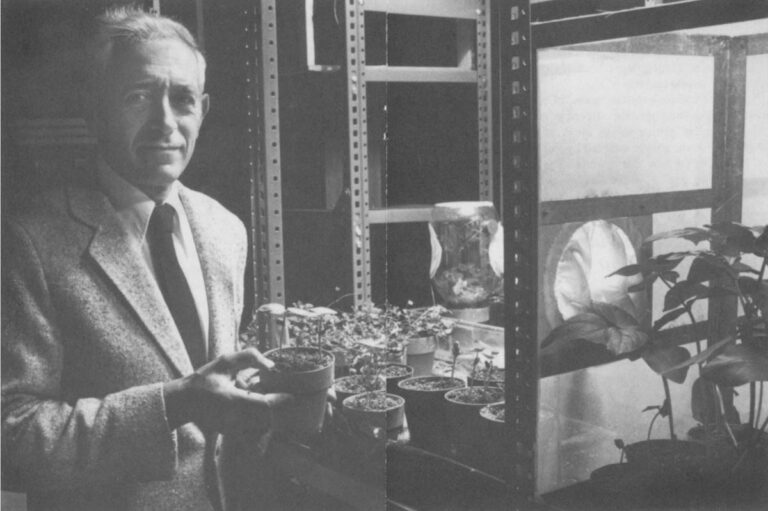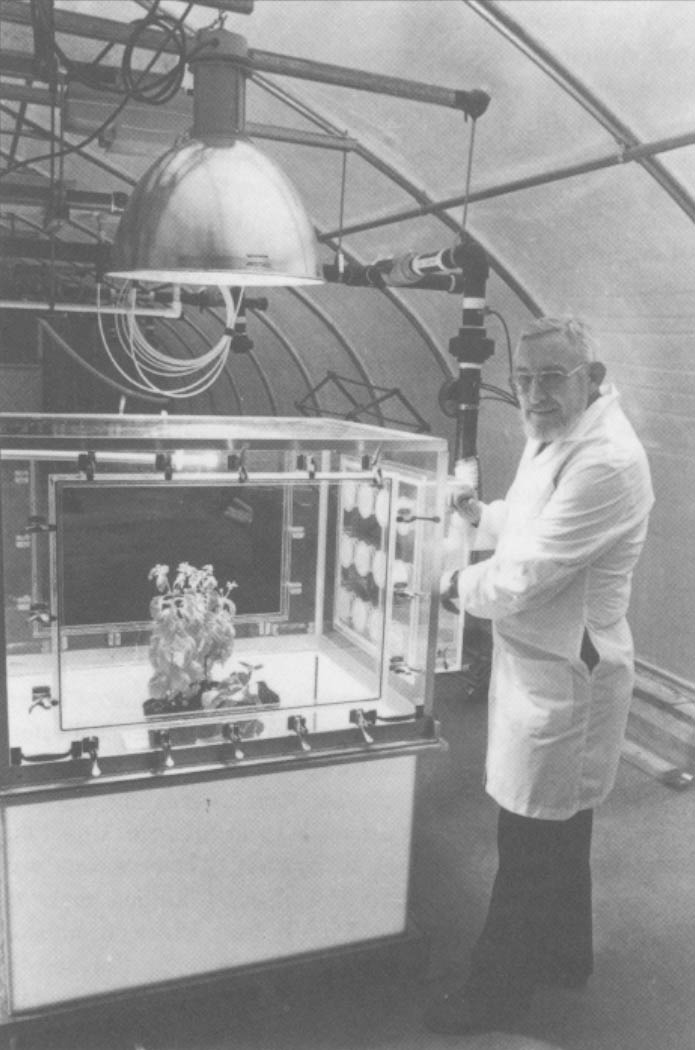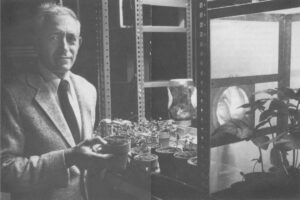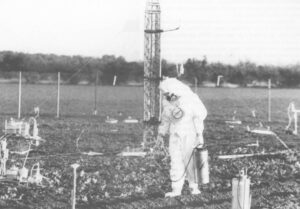Leading the way into the back room of his Cornell University laboratory, insect ecologist David Pimentel taps at the plexiglas walls of a chamber the size of a dishwasher. Inside this giant terrarium. Sucking obliviously at the stems of cowpeas are crowds of aphids, which are plant lice the size of pinheads.
The government of Indonesia has asked Pimentel to find natural predators to combat two aphids plaguing the islands’ soybean crops. But the Indonesians want to be fairly certain they are not swapping one pest for-another.

So Pimentel will try out each candidate–ladybird beetles and tiny parasitic wasps–by, letting them wreak havoc in the artificial world of these plexiglas “microcosms.” Even his testing is complicated by the fact that neither the United States nor Indonesia wants the other nation’s aphids, wasps or beetles imported, even for well-intentioned research. So the aphid victims in his lab are surrogates from Georgia.
Few biologists today would question the need for caution in introducing novel creatures into an ecosystem. Troublesome imports are legendary: Killer bees, Japanese beetles, Starlings, Kudzu vines, Chestnut blight. The gypsy moth, brought into the United States for research, escaped when a windstorm blew over its cages.
Over the past five years, however, ecologists like Pimentel have roused the ire of molecular biologists by seeking to apply these experiences with exotic organisms to another regulatory issue–the outdoor testing of life forms altered in the laboratory by recombinant DNA techniques.
The resulting scientific clash–spilling into the news media, congressional hearings and even the courts–has helped to slow the pace of field trials of genetically engineered organisms almost to a standstill.
Genetic engineers and ecologists coexisted peacefully–almost oblivious of’ one another’s work–so long as the living products of recombinant DNA technology were confined to labs and manufacturing plants. About five years ago, however, some experiments reached the stage where outdoor testing, was required if genetically engineered crops and microbes were to prove their worth to agriculture.
Federal regulators, under fire from anti-biotechnology activists and accustomed to dealing only with laboratory safety issues, began to call on ecologists for the first time to help them assess the potential environmental impacts of these releases.
Opposition to outdoor testing had until then centered on the apocalyptic visions of self-styled social activist Jeremy Rifkin, who wants a moratorium on agricultural biotechnology, believing it “robs life of all sacred meaning.” Many scientists and mainstream environmental activists believe Rifkin’s extreme views had driven away the more thoughtful critics of the field. The prospect of outdoor testing. however, brought them back.
“Rifkin essentially solidified a concern–the extreme edge of a concern, I’ll admit–but solidified a concern that a lot of us had that we were moving into an area where almost every technology that we’ve moved into with this much fanfare has usually tripped over its shoelaces halfway down the hall,” recalls James Gillett, director of the Institute for Comparative and Environmental Toxicology at Cornell. He and other ecologists say their aim, unlike Rifkin’s. is not to stop the technology but to save it from the blind enthusiasm of its developers.

“What we ought to be doing is working together so that we keep this technology–because I think it’s a good one–functioning, effective and serving society,” says Pimentel, who joined Rifkin in a 1983 lawsuit that delayed field testing of bacteria engineered to protect potato plants from frost. “I hope we don’t do what we’ve done to nuclear energy. That is, through mismanagement destroy a good technology. If they get a gypsy moth released that you can’t control, or an animal disease, it’ll set that technology back on its ear 20 or 30 years.
For their part, molecular biologists resent not only the patina of legitimacy ecologists have provided to Rifkin, but the fears this has stirred among a scientifically unsophisticated public. Based on the testimony of ecologists, a congressional staff report concluded that the risks of biotechnology are “low probability, but of high consequence.” In a similar vein, Cornell microbial ecologist Martin Alexander wrote: “Even if the risk is small, the consequences of an unlikely event could be enormous.” But what worse-case consequences do these generalities imply?
Down the street from Pimentel’s lab, in an older Cornell building, Gillett agrees that the concept of an ecological catastrophe probably means something quite different to laymen worried about AIDS and plagues than to him and his colleagues. He points to his office walls as an example. Under the layers of paint, the paneling is chestnut. “The chestnut was the major tree in many eastern forests. Chestnut blight (a fungal disease introduced accidentally from China) decimated them. Within my lifetime it’s had a major impact on forests within the eastern United States. It’s been an ecological catastrophe,” Gillett notes. “But it doesn’t seem to affect our lives all that much that we don’t have chestnuts. We’ve got knotty pine and plastic-coated Douglas fir plywood now to replace it.”
Analogies like chestnut blight are a troubling centerpiece in this scientific standoff, because without direct experience gained from outdoor testing of recombinant organisms, neither side has had much else to guide its attempts at risk assessment. The result is that ecologists and molecular biologists have each come up with competing analogies to answer the fundamental question involved:
How is a bacterium, a pig or a plant with a new gene added–or with one of its own genes deleted–most likely to behave in the world?
- Like a gypsy moth, kudzu vine or chestnut blight; or
- Like a poodle, a corn hybrid or a Holstein cow?
Some ecologists believe (A) is a realistic possibility. And to them, such releases should be just as stringently regulated as the introduction of novel or exotic natural creatures lest these lab-made organisms multiply out of control and harm our crops, livestock or natural ecosystems.
Even these ecologists agree, however, that gypsy moths and starlings are rare occurrences. Most creatures die off when placed in strange environments. And of those that do survive, few become pests. One often-quoted study showed that of 854 exotic creatures that did become successfully established in new settings, only 71 killed off a native species.
But the newly found ability of genetic engineers to ignore species barriers, putting human genes into pigs or petunias, for instance, worries some ecologists. Could new traits and abilities allow a creature to escape competitive pressures that had held its population in check? Could it evolve more rapidly now that its genes have been shuffled, perhaps developing into a disruptive “super species”?
Martin Alexander has suggested a five-step procedure for evaluating the risk of releasing any specific organism: Will it survive? Can it multiply? Can it disperse to new sites? Can it share its new genes with other species? And finally, can it–or another species carrying its genes–cause harm?
For their part, molecular biologists and agricultural scientists generally choose analogy (b). They view their creations not as fiercely competitive exotics but as slightly altered versions of native species, no more likely to disrupt the environment–or even survive long without human aid–than domesticated dogs, cattle and crops genetically altered by traditional breeding practices. A tomato with one new gene is not a “novel life form,” they argue, and has no chance of becoming a weed. Since the answer to Alexander’s final question is most likely to be “no,” they contend there’s no point in belaboring the first four questions.
“Thousands of strains of rhizobia (nitrogen-fixing bacteria) have been put out in the fields in Wisconsin since the turn of the century to increase the yield of alfalfa and soybeans,” declares Winston Brill, a bacteriologist and vice president of research and development at Agracetus in Wisconsin. “Every plant pathology department in every major school puts out known pathogens every year for tests. Nobody has given me one example of a problem.” Ecologists are ignoring the experience of agriculture, he says.
Others argue that nature itself, through millions of years of evolution, has tried out all possible genetic variations, so genetic engineers are really doing nothing new. The “balance of nature” will keep mutant creatures in line, usually preventing their survival and certainly checking the development of any “super species.” As Bernard Davis, emeritus professor of bacterial physiology at Harvard Medical School, puts it, “we must recognize severe limits to the power of molecular genetics to remake the living world.”
In September, a panel of the National Academy of Sciences (NAS) concluded that both analogies have some validity, but only in specific circumstances.
Molecular biologists are correct in saying that a creature modified by recombinant DNA techniques “is not a ‘novel’ organism, rather, it is like a breeder’s new variety of a flower,” the report found. After “many thousands of distant genetic transfers” carried out between species in the lab over the past decade, recombinant organisms behave just as predicted: like their parents but with the expected new trait conferred by the foreign gene. It’s of no concern where the new gene came from or how it was inserted, the panel said. Thus “there is no evidence that unique hazards exist either in the use of (recombinant DNA) techniques or in the movement of genes between unrelated organisms.”
If the modified organism is put back into the environment from which it came, the report noted, traditional breeding is the “most appropriate model.” But if it is to be introduced into “quite different environments or geographic locations, the accumulated experience with introduced species is most appropriate for risk assessment.”
There is also very little chance of inadvertently converting a crop plant into a weed or a benign bug into a disease-causing organism, the panel reported. A pathogenic microbe requires a complex set of skills. It must be able to attach to the proper cells in its host, resist host defenses, produce toxins, spread readily, invade new hosts and survive for a time outside the host. An “ideal weed” may need a dozen specialized traits. Thus transferring a single gene, which carries instructions for making a single protein and defines, at most, a single trait, is unlikely to turn a benign creature into a pest.
But the panel also noted that genetic engineers cannot rely on “balance of nature” or evolutionary arguments to proclaim their work completely risk free. It is “quite likely” that today’s genetic techniques will result in novel mixes of organisms, traits and environments.
But adequate knowledge and experience already exist to guide the “safe and prudent use of such organisms outside research laboratories,” the panel concluded. The need now is to create risk categories to “avoid inhibiting the development and testing of low-risk organisms.” These categories should focus on the nature of the creature and the environment into which it is to be placed, not on how it was made or where the pieces came from.
Some believe meaningful risk categories would be easier to devise if ecology–especially microbial ecology–were a more advanced science. Over the past 15 years, as the “Earth Day” spirit of the sixties gave way to the reductionist focus of molecular biology, interest among scientists dropped from the organism and ecosystem level to genes and molecules. Funding and new recruits for ecology declined. As a result, the controversy over genetically engineered organisms caught the field unprepared, its resources already spread thin by issues such as hazardous waste management.
Renewed funding has been one of the spin-offs of the controversy, although ecology still receives only a fraction of the amount invested in biotechnology. Between the Environmental Protection Agency (EPA), the National Science Foundation and private industry, about $15 to 20 million a year is going into the field now, Gillett estimates.
Some researchers are trying to outline general predictive principles: What makes a community more vulnerable to successful invasion? What are the characteristics of a successful invader? Which successful invaders are likely to become pests to our crops and livestock? Others are focusing on the basic relationships of bacteria, fungi, amoebae, protozoa’s and zooplankton in soil and water, and what happens when these are disrupted.
On a tour of his new greenhouse, filled with rows of expensive, high-tech microcosms, Gillett can quickly dispel the notion of an ecologist as a bucolic naturalist. This is modern quantitative biology. Taking a cue from satellite remote sensing, Gillett wants to develop infrared scanning methods to estimate biomass in his microcosms without taking samples. Data on soil, air and microbes in the system is being fed into Cornell’s supercomputer, and Gillett talks of using power spectrum analysis to look at shifts in respiration, photosynthesis, etc. as insects are born and die and fungi grow and fruit.
Ironically, he and other ecologists are also turning, to the tools of genetic engineering to help them study natural gene swapping and track microorganisms. So too, biotechnology companies are increasingly relying on ecology to help assure the intended “performance characteristics” of bugs and plants destined for use in the environment.
Gillett admits one of the hardest things about studying the potential impacts of genetically engineered organisms is that there are no problems to examine yet. The first field trials–of frost-retarding bacteria and plants endowed with insect, virus, and herbicide resistance–have been completed without complications or lasting impacts.
“I wish we’d make a mistake soon,” Gillett muses. “Not a disaster; just a little mistake. Because it would become a driving force for getting things done. If we don’t make a mistake very soon, people are really going to get blasé about this. I really worry now that if we’re very good at this, if our assessments are perfect, in the long run we’re really going to get fooled.”
Despite the rhetoric and clash of analogies, none of the ecologists prominent in the debate want to see progress in biotechnology delayed until their science is more advanced.
“You cannot stop society from moving ahead to solve its problems just because you don’t have an adequate data base,” Alexander says. “The need for information should not preclude moving ahead cautiously, or we’d do nothing.”
Even Pimentel agrees that enough is known to make adequate risk assessments in individual cases. And most ecologists look forward to the possibility that genetically engineered organisms will ultimately benefit the environment.
“The number of successes using natural biological controls instead of pesticides has been just a handful,” Gillett notes. “That means that guys like David Pimentel are searching, searching, searching for the right pathogen that’s going to be successful. It’s really tough. One of the reasons I’m very much interested in (biotechnology) is that I see an opportunity to reduce our pesticide inputs and get rid of hazardous chemicals in the environment by using genetically engineered organisms. I don’t want to interfere with that possibility if we can help it and promote it reasonably.”
“There’s no rationale for blocking all releases,” agrees Simon Levin, director of Cornell’s Center for Environmental Research and a member of the NAS panel. “But there’s also no generic basis for giving a clean bill of health to all of these organisms any more than we would any other introductions into the environment. And we don’t have a classification scheme yet, although we have the basis for developing one. So the best we can do for the moment is put them through the hoops. How many hoops to put them through is what’s debatable.”
Indeed, as the lineup of organisms ready for field testing grows, the number and nature of these “hoops” is the central question facing federal regulators.
©1987 Yvonne Baskin
Yvonne Baskin, a free-lance science writer, is reporting on the release of genetically engineered organisms into the environment.




